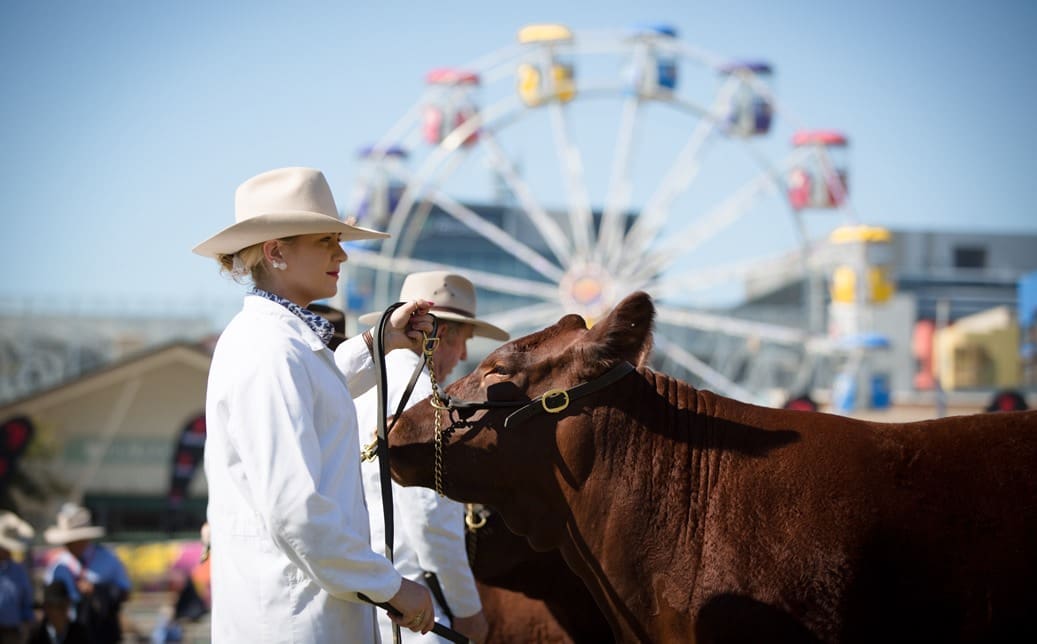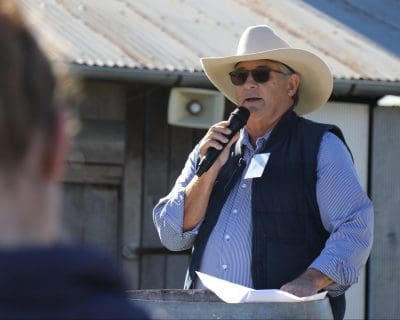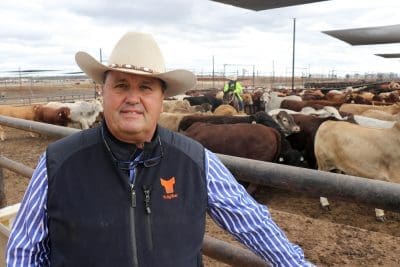
COVID may have culled the popular annual city-country catch-up at “the Ekka” – as the Brisbane Exhibition was long-ago coined – for the second consecutive year thanks to COVID, but the conversation about cattle and shows has carried on this week via the Weekly Grill podcast.
In his most recent edition Kerry Lonergan discusses the future of cattle shows with two of the most experienced cattle breeders and Ekka exhibitors in the business.

Gary Noller, announcing the results of this year’s Paddock to Palate weight gain section winners at the Jondaryan Woolshed.
Gary Noller is a long-time stud and commercial Charolais breeder, exhibitor and cattle judge who has served for several years as the RNA councillor in charge of beef at the Brisbane Ekka. Rob Sinnamon from Yulgilbar Santa Gertrudis Stud in Northern New South Wales is one of the most successful exhibitors of all time in stud and commercial Royal show contests and a nationally renowned judge of stud and commercial cattle.
While objective measurement technology and data has provided a powerful tool in the never ending quest for the most commercial relevant cattle, traditional visual assessment will always play an crucial role in livestock breeding, both firmly believe.
Utilising all tools that are available was certainly useful, Mr Sinnamon said, but ultimately structural correctness remains crucial.
“If you don’t have a sound basis to begin with, it’s very difficult to build off,” he explained.
“Certainly, you need that correctness in the feet and legs, reproductive soundness, and then the commercial performance to go with that.
“So, those things always play very heavily on my mind when I’m looking at animal.”
Gary Noller said structural soundness and correctness went hand and hand with fertility and were two traits the should be “right at the top of your list” when looking at breeding stock.
“Structurally if they’re not right, they don’t last and, I don’t care how many people tell you that sex is good. When it hurts, bulls don’t do it and you don’t get cows and calves.”

Rob Sinnamon.
Mr Sinnamon said in his view the value of entering stud shows and commercial competitions was two-pronged.
“It gives us an opportunity to benchmark our genetics, to understand how they’re compared to everyone on the east coast of Australia, particularly, of all breeds, and it’s a way of aligning our commercial program with requirements of the industry.
“And, secondly, it’s a great advertising tool to promote our seedstock, our genetics when it comes to selling our annual bull sale.”
Ongoing disruptions caused by COVID were forcing studs to reach for different ways to show their cattle to clients, he said.
“I think it’s been a shift in how we promote our cattle. I guess we’re all learning to photograph and video much more extensively and provide more data for those who are unable to travel. I think it’s here to stay.
“I think there will always be a preference in the seedstock market to physically see those animals that are going to attract a premium or record dollar, but I guess as in building client trust with one’s breeding program, it’s guaranteeing the repeatability of the cattle that you produce.
“And if you can build that trust, the rapport with your client over time, I see the commercial cattleman utilising it (digital promotion) more and more, providing they have that trust in the business that they’re dealing with.”
Mr Noller said that after the “frame races” of the 1990s/2000s which saw some monster-sized bulls entering show rings, trends have settled toward more moderate, middle of the road cattle.
Breeding commercially relevant cattle was a constant challenge to strike the right balance between weight gain and meat quality, he said, two parameters which are antagonistic – push to hard on one and you can detrimentally affect the other.
Breeding cattle was a lot like golf, he said.
“You can hit that ball off the tee, down the fairway, 300 metres sometimes and you don’t often do it many times after that, or I don’t anyway, and it just keeps you going.
“You know you can do it. You don’t always do it, but it’s that knowing that you can that drives you into going back and keep on doing it, trying to improve the whole time.
“So, the seedstock is just like that.
“You know you can breed good bull, but sometimes the environment or programs don’t work and we’re all – we have brothers and sisters. We’re all different.
“And that’s that game as well. Genetics play a very important part, but they don’t always mix the way you like them to mix.”
- To listen to the full episode featuring Kerry Lonergan’s interviews with Gary Noller and Rob Sinnamon (full length 38 minutes) click here
